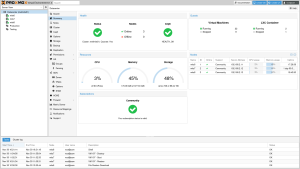Main Page: Difference between revisions
m (external links get already a nice "open external link" icon from MW) |
|||
| Line 32: | Line 32: | ||
If you are new to Proxmox VE the following chapters will help you to start: | If you are new to Proxmox VE the following chapters will help you to start: | ||
* [[Qemu/KVM Virtual Machines|QEMU/KVM Virtual Machines]] and [[Linux Container]] are the two types of virtualization technologies supported by Proxmox VE | * [[Qemu/KVM Virtual Machines|QEMU/KVM Virtual Machines]] and [[Linux Container]] are the two types of virtualization technologies supported by Proxmox VE | ||
* [[Host System Administration]] will detail all the tasks commonly done on the Proxmox VE host such as setting [[Package Repositories]], [[Network Configuration]], [[System Software Updates]], [[External Metric Server]], [[Disk Health Monitoring]], [[Logical Volume Manager (LVM)]], [[ZFS on Linux]] | * [[Host System Administration]] will detail all the tasks commonly done on the Proxmox VE host such as setting [[Package Repositories]], [[Network Configuration]], [[System Software Updates]], [[Host Bootloader]], [[External Metric Server]], [[Disk Health Monitoring]], [[Logical Volume Manager (LVM)]], [[ZFS on Linux]] | ||
* [[Cluster Manager]] will explain to you how to connect your Proxmox VE hosts in clusters | * [[Cluster Manager]] will explain to you how to connect your Proxmox VE hosts in clusters | ||
* You can configure [[High Availability]] for your virtual machines and containers once you have setup a cluster | * You can configure [[High Availability]] for your virtual machines and containers once you have setup a cluster | ||
Revision as of 09:27, 4 May 2022
|
Today, 21 November 2024, there are 247 articles available. Proxmox Virtual Environment is an open source server virtualization management solution based on QEMU/KVM and LXC. You can manage virtual machines, containers, highly available clusters, storage and networks with an integrated, easy-to-use web interface or via CLI. Proxmox VE code is licensed under the GNU Affero General Public License, version 3. The project is developed and maintained by Proxmox Server Solutions GmbH. For an overview of the Proxmox VE key features see the Proxmox website. DownloadsDownload our latest ISO image. InstallationYou can install Proxmox VE either on your hardware from USB or CD-ROM using our ISO image, or alternatively on top of an existing Debian installation. Upgrading Proxmox VESystem Software Updates are downloaded from the Package Repositories and should be applied frequently to receive the most recent bug/security fixes and to obtain the newest features. You can also upgrade existing Proxmox VE installations to the next major release: See the supported release table for the current release and the end of life date of older releases. Using Proxmox VEThis wiki includes the complete Proxmox VE Reference Documentation If you are new to Proxmox VE the following chapters will help you to start:
Offline DocumentationThe complete Proxmox VE Reference Documentation is also available offline in different formats such as html, pdf or epub. This documentation is also included in each PVE installation, and is accessible via contextual help buttons. HOWTOs & Troubleshooting
Release History and RoadmapTake a look on the Roadmap for existing and upcoming features. Video TutorialsFor new Proxmox VE users, we regularly publish video tutorials on our website, see https://www.proxmox.com/training/video-tutorials. TestimonialsCompanies regardless their size, sector, or industry, as well as universities, public institutions and non-profits use Proxmox VE in their production environment. Take a look on our testimonials page. |
